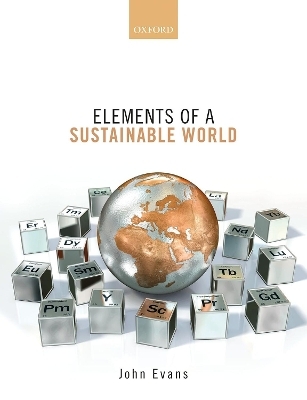
Elements of a Sustainable World
Oxford University Press (Verlag)
978-0-19-882783-2 (ISBN)
- Lieferbar
- Versandkostenfrei
- Auch auf Rechnung
- Artikel merken
This book is designed around providing a one semester course for students who have entered at least the second level of university chemistry. It provides explanations and entries to current environmental issues. For students of environmental science, it provides an understanding of the chemical principles underpinning the causes and possible solutions to these issues. Each chapter has a set appropriate study questions. A study guide is available for the book.
John Evans holds a BSc (Imperial College) and PhD (University of Cambridge) in Chemistry. Following further periods of research at Princeton University and Cambridge he moved to the University of Southampton in 1976 as a Royal Society Pickering Research Fellow. He became Professor of Inorganic Chemistry in 1990. There he has served as Head of Teaching, Head of Department and Dean of Science. He was also Science Program Advisor at the Diamond Light Source
1 Planet Earth
1.1: Planetary resources
1.2: Differential pressure on land, freshwater and oceans
1.3: Effects of CO2 increases
1.4: Solar energy supply
1.5: Solar radiation spectrum
1.6: Absorption of the energy emission from Earth
1.7: Radiative Forcing
1.8: Atmospheric lifetime
1.9: Global Warming Potential
1.10: The energy balance
1.11: A sustainable approach
1.12: Questions
Palette of the Elements
2.1: Natural abundance of the elements
2.2: Mineral availability
2.3: Element Transmutation
2.4: Element supply
2.5: Elemental Properties
2.6: Element extraction: solubility
2.7: Oxidation State Stability
2.8: Terms and States
2.9: Embodied energy, carbon and water
2.10: Questions
Earth: Minerals to Materials
3.1: s elements
3.2: p-elements
3.3: d-elements
3.4: f -elements
3.5: Structural Materials
3.6: Questions
Air
4.1: The volatile elements
4.2: Atmospheric components
4.3: Atmospheric solution: wind turbines
4.4: Question
Fire
5.1: Petrochemicals from carbon oxides
5.2: Polymers
5.3: Chemicals from biomass alternatives
5.4: Solar energy conversion
5.5: Nuclear energy conversion
5.6: Hydrogen as a fuel
5.7: Batteries and supercapacitors
5.8: Questions
Water
6.1: Properties of water
6.2: Distribution of water
6.3: Distribution of elements in water
6.4: Water in processing
6.5: Desalination of water
6.6: Seawater as a source of elements
6.7: Water remediation from heavy metals and organics
6.8: Other organic contaminants of water
6.9: Questions
Prospects for Planet Earth
7.1: Chapter 1: Planet Earth
7.2: Chapters 2 and 3: Palette of the Elements and Earth
7.3: Chapter 4: Air
7.4: Chapter 5: Fire
7.5: Chapter 6: Water
7.6: Questions
Study Guide
Overview
Chapter 1: Planet Earth
Chapter 2: Palette of the Elements
Chapter 3: Earth
Chapter 4: Air
Chapter 5: Fire
Chapter 6: Water
Chapter 7: Prospects
| Erscheinungsdatum | 11.11.2020 |
|---|---|
| Zusatzinfo | 287 |
| Verlagsort | Oxford |
| Sprache | englisch |
| Maße | 196 x 253 mm |
| Gewicht | 870 g |
| Themenwelt | Naturwissenschaften ► Biologie ► Ökologie / Naturschutz |
| Naturwissenschaften ► Chemie | |
| Naturwissenschaften ► Geowissenschaften ► Geologie | |
| ISBN-10 | 0-19-882783-0 / 0198827830 |
| ISBN-13 | 978-0-19-882783-2 / 9780198827832 |
| Zustand | Neuware |
| Haben Sie eine Frage zum Produkt? |
aus dem Bereich


